Magnesium chloride bonded phosphate rock powder agglomeration
The production of calcium magnesium phosphate fertilizer by blast furnace method has certain requirements on the particle size of phosphate rock and flux entering the furnace. Screening off fine ore less than 10mm is one of the important prerequisites for smooth operation, high yield, stable yield and low consumption of blast furnace. However, at present, the content of fine ore in the raw phosphate ore is as high as 20-40%, so the treatment of fine ore has become an urgent problem to be solved in the current phosphate fertilizer plant.
At present, the treatment methods for fine ore include:
1. Grinding is used as phosphate rock powder fertilizer or calcium superphosphate production, but it is limited by conditions, so the treatment capacity is not large.
2. Raw ore enters the furnace, but it is technically and economically unreasonable.
3. Fine ore sintering. Although the sinter produced by this method has good performance, the fluorine-containing waste gas is difficult to treat and the working conditions are relatively poor.
4. Bulk ore method has been tested and studied for more than ten years, but due to various reasons, phosphate fertilizer powder ore has not been put into calcium magnesium phosphate fertilizer production so far.
After various experiments, in the search for a new phosphate rock powder binder, it is found that bitter soil powder and magnesium chloride are mixed according to an appropriate proportion and have strong adhesion to phosphate rock powder. The phosphate rock agglomerate bonded by this method has high strength and good thermal stability. Although the content of binder in agglomerate is relatively low, it has already met the technological requirements of phosphate fertilizer blast furnace. At the same time, the agglomeration process is also very simple, does not need drying, only needs natural drying, and the processing cost is relatively low. The main component of binder is magnesium oxide, which is very beneficial to blast furnace batching.


Process Flow
Phosphate rock powder with a certain particle size, bitter soil powder, magnesium chloride solution and water are prepared according to a certain proportion, mixed evenly in a mixer, made into a certain shape manually or by machine, and then cured for about 15 days to become phosphate rock powder agglomerate with suitable strength.
Economic problems
It is technically feasible to produce NP or NPK granular mixed fertilizer with urea and superphosphate as the main ingredients. However, the phosphorus in the product of this system comes from calcium superphosphate, which is limited by the nutrient content of the product. Broadly speaking, the production of granular mixed fertilizer is the processing process of fertilizer materials. Its value is based on integrating the nutritional components of basic fertilizers and improving the physical properties and fertilization methods of fertilizers. Due to the synthesis of nutrients and the improvement of their properties, it has certain advantages in realizing scientific fertilization, saving fertilization labor and improving agricultural yield increase. If the processing cost is too high and the selling price of fertilizer exceeds the benefits obtained from agricultural fertilization, then this kind of production cannot be established economically. Therefore, the production of this kind of granular fertilizer must be tested from the economic principle.
From the technical and economic analysis, urea-calcium superphosphate granular fertilizer factory should have good raw material supply conditions. The quality of superphosphate is Grade II, and the price should be calculated on the basis of workshop cost. Buy urea, potassium salt and other raw materials, should be calculated at the allocation price. If the secondary processing is carried out with the raw materials at commodity prices, in addition to the raw materials fee and operation fee, plus the expenses of packaging, management, depreciation, capital interest, taxes and profits, it cannot be established economically.
In order to ensure economic rationality, according to statistics, factories with an annual output of 50,000 tons of physical products are economically reasonable. A factory that is too small is not suitable for consideration.




